一、内存模型分区
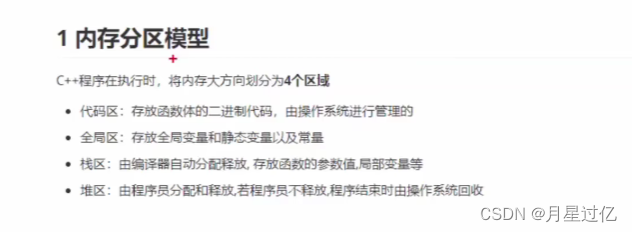
内存四区的意义:
不同区域存放的数据,赋予不同的生命周期,给我们更大的灵活编程
(一)程序运行前
在程序编译后,生成了exe可执行程序,未执行程序前分为两个区域
代码区:
- 存放cpu执行的机器指令(代码的2进制)
- 代码区是共享的,共享的目的是对于频繁执行的程序,只需要在内存中有一份代码即可
- 代码区是只读的,使其只读的原因是防止程序意外的修改了其它指令
全局区:
- 全局变量和静态变量存放在此
- 全局区还包含了常量区,字符串常量和其他常量也存放在此
- 该区域的数据在程序结束后由操作系统释放

#include<iostream>
using namespace std;
int g_a = 10;
int g_b = 10;
//const修饰的全局变量,全局常量
int c_g_a = 10;
int c_g_b= 10;
int main()
{
//全局区
//全局变量、静态变量、常量//创建普通局部变量
int a = 10;
int b = 20;
cout << "局部变量a的地址为:" << (int)&a << endl;
cout << "局部变量a的地址为:" << (int)&b << endl;
cout << "全局变量g_a的地址为:" <<(int)&g_a << endl;
cout << "全局变量g_b的地址为:" <<(int)&g_b << endl;
//创建静态变量
static int s_c = 10;
static int s_d = 10;
cout << "静态变量s_c的地址为:" << (int)&s_c << endl;
cout << "静态变量s_d的地址为:" << (int)&s_d << endl;//常量
//字符串常量
cout<<"字符串常量的地址为:"<<(int) & "hello world"<<endl;
//const修饰的变量
//const 修饰的全局变量
// const修饰的局部变量
const int c_l_a = 10;
const int c_l_b = 10;
cout << "const修饰的全局常量c_g_a的地址为:" << (int)&c_g_a << endl;
cout << "const修饰的全局常量c_g_b的地址为:" << (int)&c_g_b << endl;
cout << "const修饰的局部变量c_l_a的地址为:" << (int)&c_l_a << endl;
cout << "const修饰的局部变量c_l_b的地址为:" << (int)&c_l_b << endl;
system("pause");
return 0;}#include <iostream>
using namespace std;
//栈区数据的注意事项 ---不要返回局部变量的地址
//栈区的数据由编译器管理开辟和释放int* func(int b) {//形参数据也会放在栈区b = 200;int a = 10;//局部变量 存放在栈区,栈区的数据在函数执行完后自动释放return & a;//返回局部变量的地址}
int main() {//接受func函数的返回值int *p = func(1);cout << "p = " << *p << endl;cout << "p = " << *p << endl;system("pause");return 0;
}(二)程序运行后
栈区:
- 由编译器自动分配释放,存放函数的参数值,局部变量等
- 注意事项:不要返回局部变量的地址,栈区开辟的数据由编译器自动释放
#include <iostream>
using namespace std;
//栈区数据的注意事项 ---不要返回局部变量的地址
//栈区的数据由编译器管理开辟和释放int* func(int b) {//形参数据也会放在栈区b = 200;int a = 10;//局部变量 存放在栈区,栈区的数据在函数执行完后自动释放return & a;//返回局部变量的地址}
int main() {//接受func函数的返回值int *p = func(1);cout << "p = " << *p << endl;cout << "p = " << *p << endl;system("pause");return 0;
}堆区:
- 由程序员分配释放,若程序员不释放,程序结束时由操作系统回收
- 在c++中主要利用new在堆区开辟内存
#include<iostream>
using namespace std;int * func() {//利用new关键字 可以将数据开辟到堆区//指针 本质也是局部变量,放在栈上,指针保存的数据是放在堆区int * p = new int(10);return p;}int main() {//在堆区开辟数据int *p=func();cout << "p=" << *p << endl;system("pause");return 0;
} 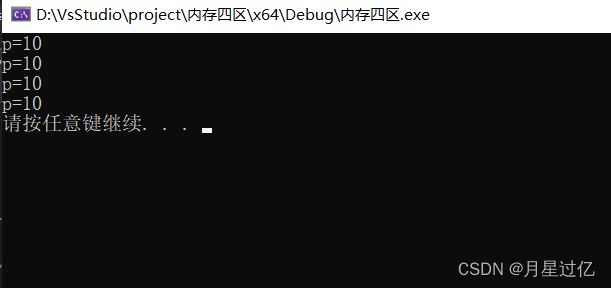
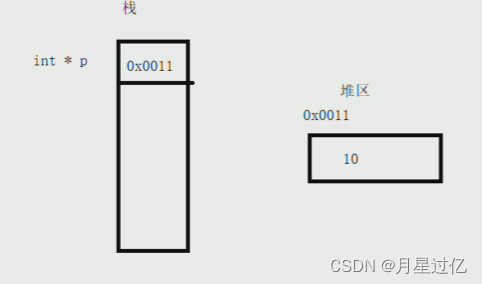
(三)new操作符
- c++中利用new操作符在堆区开辟数据
- 堆区开辟的数据,由程序员手动开辟,手动释放,释放利用操作符 delete
- 语法: new 数据类型
- 利用new创建的数据,会返回该数据对应的类型的指针
没有进行delete清除时
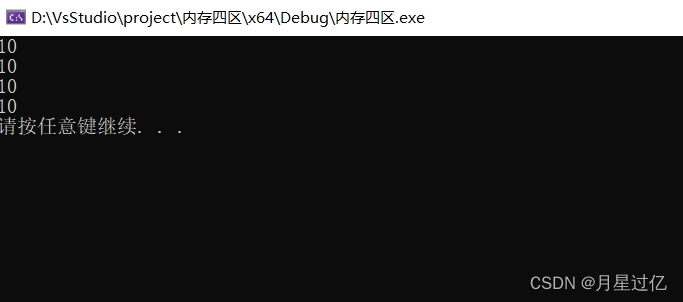
使用delete进行清除后
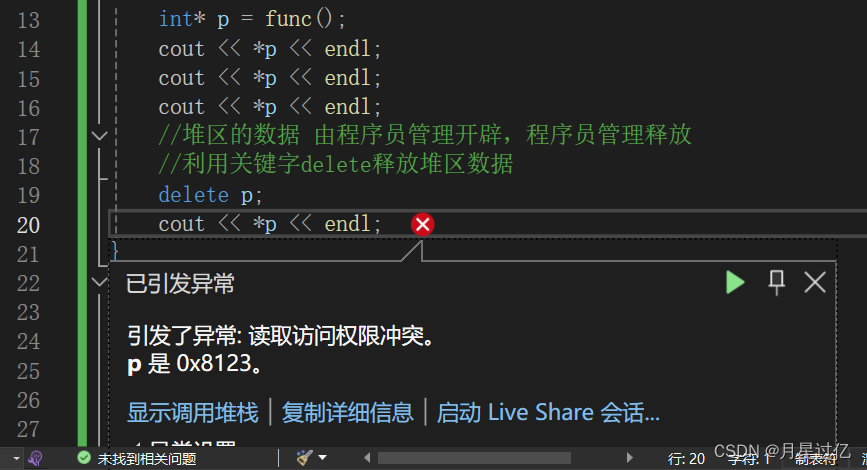
#include <iostream>
using namespace std;
//1、new的基本语法
int* func() {//在堆区创建整形数据//new返回的是一个该数据类型的指针int *p = new int(10);return p;}
//2、在堆区利用new开辟数组
void test02() {//创建10整型数据的数组,在堆区
int * arr= new int[10];//10代表数组有10个元素
for (int i = 0; i < 10; i++)
{arr[i] = i + 100;
}
for (int i = 0; i < 10; i++) {cout << arr[i] << endl;
}
//释放数组的内存空间
delete[] arr; //释放数组需要加[]
}
void test01()
{int* p = func();cout << *p << endl;cout << *p << endl;cout << *p << endl;//堆区的数据 由程序员管理开辟,程序员管理释放//利用关键字delete释放堆区数据delete p;}
int main()
{test01();test02();system("pause");return 0;}二、引用
(一)引用的基本使用
作用:给变量起别名
语法:数据类型 &别名=原名
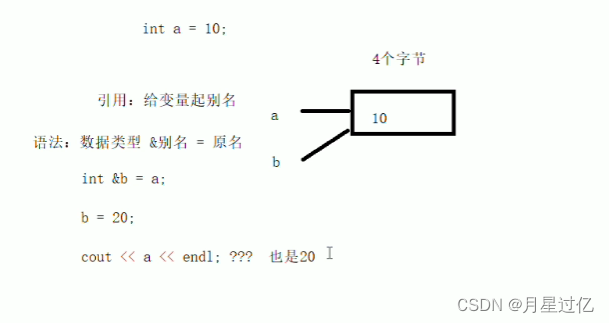
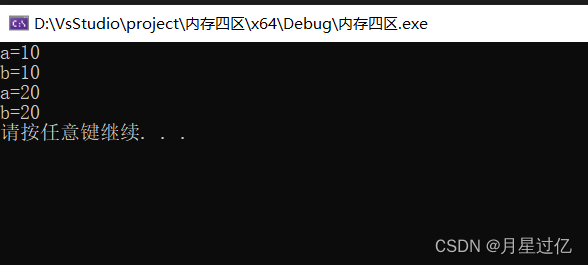
#include<iostream>
using namespace std;int main() {//引用的基本语法//数据类型 &别名 =原名int a = 10;int& b = a; //b是a的引用cout << "a=" << a << endl;cout << "b=" << b << endl;b = 20; //修改b的值,a也会跟着变化cout << "a=" << a << endl;cout << "b=" << b << endl;system("pause");return 0;}(二)引用的注意事项
- 引用必须初始化
- 引用在初始化后,不可以改变
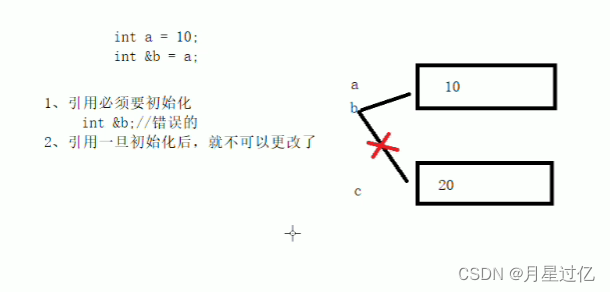
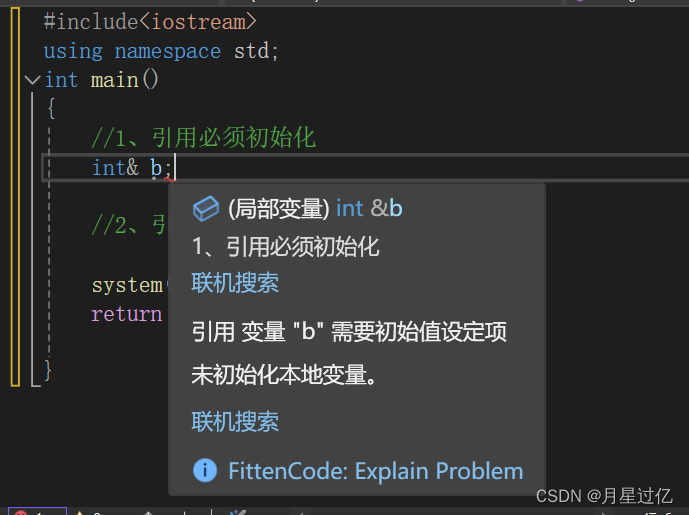
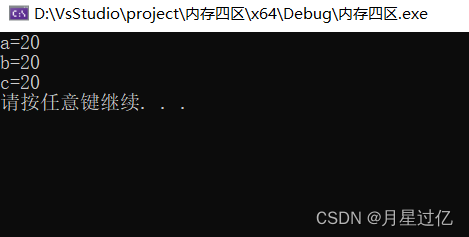
#include<iostream>
using namespace std;
int main()
{int a = 10;//1、引用必须初始化//int& b; //错误,必须要初始化int& b = a;//2、引用在初始化后,不可以改变int c = 20;b = c;//赋值操作而不是更改引用cout << "a=" << a << endl; //输出20cout << "b=" << b << endl; //输出20cout << "c=" << c << endl; //输出20//3、引用的本质是指针,因此可以直接操作指针指向的内存空间system("pause");return 0;}(三)引用做函数参数
- 作用:函数传递时,可以利用引用的技术让形参修饰实参
- 优点:可以简化指针修改实参
#include <iostream>
using namespace std;
//交换函数//1.值传递
void mySwap01(int a,int b) {int temp = a;a = b;b = temp;
}
//2.地址传递
void mySwap02(int* a, int* b) {int temp = *a;*a = *b;*b = temp;
}
//3.引用传递
void mySwap03(int &a, int &b) {int temp = a;a =b;b = temp;
}int main() {int a = 10, b = 20;cout << "a = " << a << " b = " << b << endl;mySwap01(a, b);//值传递 形参不会修饰实参cout << "a = " << a << " b = " << b << endl;mySwap02(&a, &b);//地址传递 形参会修饰实参cout << "a = " << a << " b = " << b << endl;mySwap03(a, b);//引用传递 形参会修饰实参cout << "a = " << a << " b = " << b << endl;system("pause");return 0;
}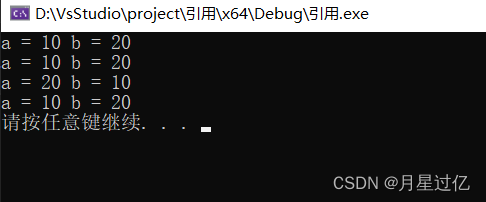
(四)引用做函数返回值
作用:引用是可以作为函数的返回值存在
注意:不要返回局部变脸引用
用法:函数调用作为左值
#include <iostream>
using namespace std;
//引用做函数的返回值//1.不要返回局部变量的引用
int& test01() {int a = 10;return a; //错误,局部变量的引用不能作为函数的返回值
}//2.函数的调用可以作为左值
int & test02() {static int a = 10;//静态变量(全局变量)return a;
}int main() {int & ref = test01();cout << ref << endl; //第一次结果正确,是因为编译器做了保留cout <<"ref=" << ref << endl;//第二次结果错误,是因为a的内存已经释放cout << ref << endl;cout << ref << endl;cout << ref << endl;cout << ref << endl;int &ref2 = test02();cout << ref2 << endl;cout << ref2 << endl;cout << ref2 << endl;test02() = 1000;//如果函数的返回值是引用,这个函数调用可以作为左值cout << "ref2=" << ref2 << endl;cout << "ref2=" << ref2 << endl;cout << "ref2=" << ref2 << endl;system("pause");return 0;
}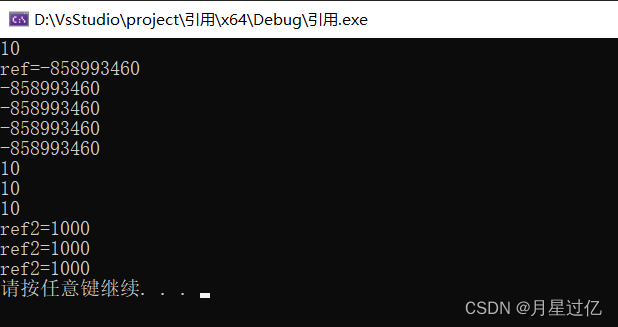
(五)引用的本质
本质:引用的本质在c++内部实现是一个指针常量
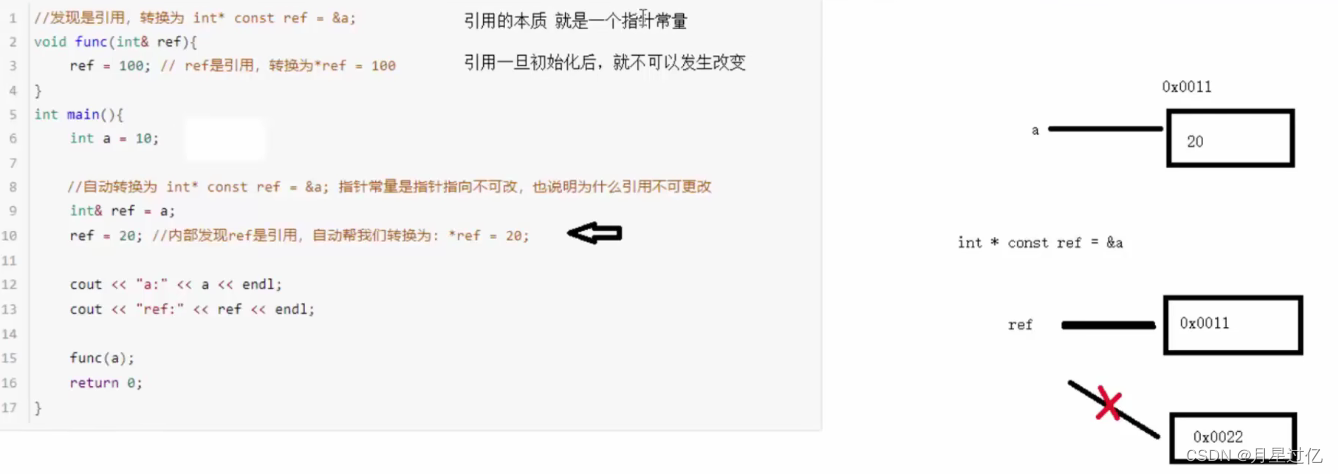
#include <iostream>
using namespace std;
//发现是引用,转换为int * const ref=&a;
void func(int &ref) {ref = 100;//ref是引用,转换为 *ref=100}int main() {int a = 10;//自动转换为 int * const ref=&a; 指针常量是指针指向不可改,也说明了引用不可更改int &ref = a; ref = 20;//内部发现ref是引用,自动帮我们转换为:*ref=20;cout << "a=" << a << endl; //a=20cout << "ref=" << ref << endl;system("pause");return 0;
}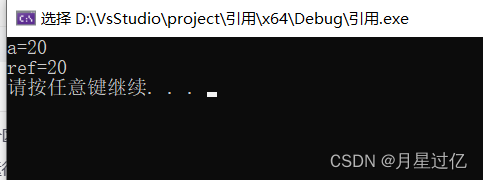
(六)常量引用
作用:常量引用主要用来修饰形参,防止误操作
在函数形参列表中,可以加const修饰形参,防止形参改变实参
不加const修饰
#include <iostream>using namespace std;
//打印数据的函数
void showValue( int & val){val = 1000;cout << "value =" << val << endl;
}
int main() {//常量引用//使用场景 用来修饰形参,防止误操作int a = 10;//加上const之后 编译器将代码修改 int temp=10;const int &ref=temp;const int& ref = 10;//引用必须引一块合法的内存空间//ref = 20;//加入const之后变为只读,不可以修改cout << "ref =" << ref << endl;int b = 100;showValue(b);//调用函数传递引用system("pause");return 0;
}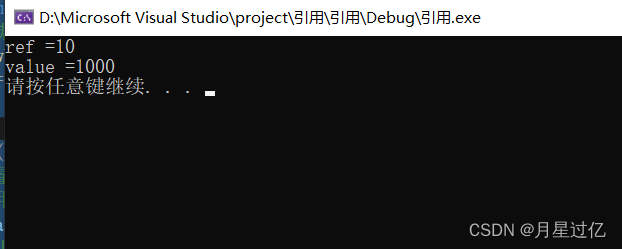
加入const修饰
#include <iostream>using namespace std;
//打印数据的函数
void showValue(const int & val){//val = 1000; //加入const 后会报错 不能修改cout << "value =" << val << endl;
}
int main() {//常量引用//使用场景 用来修饰形参,防止误操作int a = 10;//加上const之后 编译器将代码修改 int temp=10;const int &ref=temp;const int& ref = 10;//引用必须引一块合法的内存空间//ref = 20;//加入const之后变为只读,不可以修改cout << "ref =" << ref << endl;int b = 100;showValue(b);//调用函数传递引用system("pause");return 0;
}







![【2024最新华为OD-C/D卷试题汇总】[支持在线评测] LYA的巡演(100分) - 三语言AC题解(Python/Java/Cpp)](http://pic.xiahunao.cn/【2024最新华为OD-C/D卷试题汇总】[支持在线评测] LYA的巡演(100分) - 三语言AC题解(Python/Java/Cpp))

)








标签样式)